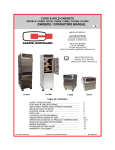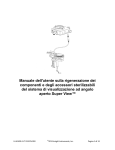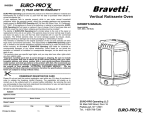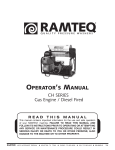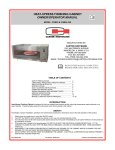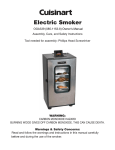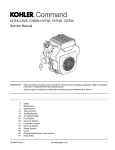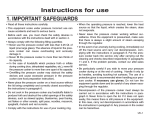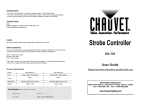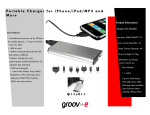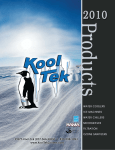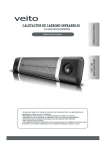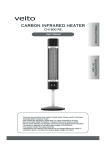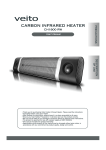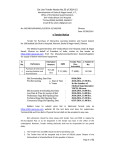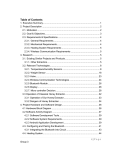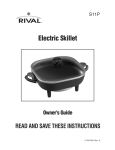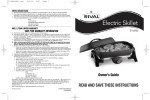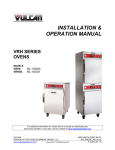Download Cook & Hold Cookbook - Carter
Transcript
COOKING GUIDE For CARTER-HOFFMANN Cook & Hold Cabinets With Carter-Hoffmann’s Slow Cook & Hold Cabinets, you can roast to perfection with a larger yield than convection oven cooking. Our secret is gentle air circulation that caramelizes the exterior of the roast, seals in moisture & cooks more evenly. And because your roasts are perfectly and naturally browned, there’s no need to dress them up with sauces and gravies. But beyond roasts, these cabinets are versatile to cook a wide variety of items. This cook book is intended to provide you with the basics of cook & hold cooking. CH1600 TABLE OF CONTENTS GENERAL SPECIFICATIONS CABINET OPERATION LOW TEMPERATURE COOKING & HOLDING BEEF RECIPES PORK RECIPES LAMB RECIPES POULTRY RECIPES FISH RECIPES MISCELLANEOUS RECIPES DETERMINING MEAT SHRINKAGE 2 3 4 5-13 14-18 19-20 21-26 27-28 29-34 35 1551 McCormick Ave. Mundelein, IL 60060 847.362.5500 ● 800.323.9793 Fax 847.367.8981 www.carter-hoffmann.com Form CHCB 0114 Cook & Hold Cabinets General Specifications (see individual spec sheets for more details) NEW Controls! Cook to time or temperature. Includes meat probe. Gentle air circulation caramelizes meat and seals in juices for perfect roasts and more portions Browning occurs naturally, without the use of gravies and sauces to colorize meats Easy-to-use controls: dial in cook temperature, hold temperature and cook time Lift-off heating system with precision engineered heat duct system for optimal air flow and even heating Hoods not required in most areas—makes installation easy and inexpensive (check local codes) CH1600 Model Number Tray Capacity 18” x 26” Tray Spacing in (mm) Approx. Meat Capacity lbs (kg) Inside Working Height in (mm) Caster Diameter in (mm) Class 100 Shipping Weight lbs (kg) CH600 6 3 (76) 80 (36) 18-1/8 (460) 38-1/2 (948) 32-3/4 (832) 26-1/8 (664) 5 (127) 275 (125) CH800 8 2-3/4 (70) 120 (54) 22 (559) 39-3/8 (1000) 32-3/4 (832) 26-1/8 (664) 3 (76) 312 (142) CH900 9 3 (76) 120 (54) 27-1/4 (692) 47-1/2 (1207) 32-3/4 (832) 26-1/8 (664) 5 (127) 344 (156) CH1600 (2 cavity) 16 (8 per cavity) 2-3/4 (70) 240 (109) 22¹ (559) 76-3/8 (1940) 32-3/4 (832) 26-1/8 (664) 5 (127) 420 (191) CH1800 18 3 (76) 240 (109) 54-1/2 (1384) 78 (1981) 32-3/4 (832) 26-1/8 (664) 5 (127) 460 (209) Overall Dimensions Height Depth Width in (mm) *12”x20”x2.5” pans may be placed on optional wire shelves. Capacities: CH600: 3 (end-loaded; 1 per shelf) CH800: 4 (end-loaded, 1 per shelf) CH900: 5 (end-loaded, 1 per shelf) CH1600: 8 (4 per cavity; end loaded, 1 per shelf) CH1800: 9 (end loaded; 1 per shelf) ¹Inside working height—each cavity APPROVALS : Model Number Pan Capacity* 12”x20” Tray Spacing in (mm) Approx. Meat Capacity lbs (kg) Inside Working Height in (mm) CH750 10 2-3/4 (70) 100 (45) 13-3/4 (349) Overall Dimensions Height Depth Width in (mm) 33-1/2 (851) 32-3/4 (832) 28-3/4 (664) Caster Diameter in (mm) Class 100 Shipping Weight lbs (kg) 2 (51) 265 (122) *18”x26” sheet pans may be placed on optional wire shelves. Capacity: CH750: 5 (end-loaded; 1 per shelf) ELECTRICAL INFORMATION Model US Electrical Power CE Electrical Power Model US Electrical Power CE Electrical Power Watts Voltage Watts Voltage Watts Voltage Watts Voltage CH600 3200 240 3000 230 CH900 3200 240 3000 230 CH750 3200 240 3000 230 CH1600 6200 240 5700 230 CH800 3200 240 3000 230 CH1800 6200 240 5700 230 2 These cooking guidelines may also be used for cooking with previous generation Cook & Hold cabinet models: CH6, CH9, CH18, CH6/6, CH6/9 (manufactured prior to 12/31/13) Cabinet Operating Instructions This cooking guide is for use with your Carter-Hoffmann cook & hold cabinet and has been developed to answer questions that you may have regarding product cooking and cabinet operation. This is to be used as a guide for the basics of cook & hold cooking. Due to the variable nature of food products and personal preferences for product quality and degree of “doneness”, we recommend that you experiment with cooking times and temperatures in your facility in order to achieve your best product quality. If you have any questions regarding the operation of your cook and hold cabinet, please call CarterHoffmann technical service at 800-323-9793. Before operating the cook and hold, read the entire Owner’s/Operator’s manual to familiarize yourself with the cabinet’s operation. YOU CAN DOWNLOAD THE COMPLETE USER’S MANUAL ONLINE AT WWW.CARTER-HOFFMANN.COM. READ OPERATION INSTRUCTIONS COMPLETELY BEFORE INSTALLING & OPERATING THIS APPLIANCE. From the home page, click on the “PRODUCTS” tab and then select from the product choices (i.e. banquet carts, holding cabinets, etc.) Once on the product page, manuals can be found in the tables by model number. Click on the corresponding manual PDF for your model number. You can locate the model number on the serial tag on the cabinet. 3 Low Temperature Cooking & Holding Cooking The purpose of low temperature cooking is increased moisture retention, tenderization and consistency of product. As a consequence, the benefit of low temperature cooking is increased product yield and therefore, increased profits. In addition, these cabinets provide labor and energy savings that further increase profitability. And because they cook at low temperature, no exhaust hood is needed (check local codes). For example: When cooking a 20 pound roast in a convection oven, the meat shrinkage will average 25%. Why? These ovens blast a high temperature dry air over the product, exploding the small blood vessels, breaking down the product structure and allowing it to dry out. Cook that same 20 pound roast at lower temperatures in a cook and hold, and shrinkage averages about 7-10%. Cooking at a lower temperature for a longer period of time, with gentle air circulation, reduces breakdown of product structure, caramelizes the exterior for an attractive roasted appearance and seals in juices. The result is a more moist and tender product, with an average of 23% more yield from the same 20 pound roast. 23% more yield = 23% more profits. A cook and hold can pay for itself in just months, depending on your volume. Caramelization is the Key Because Carter-Hoffmann cook and hold cabinets have gentle air circulation, roasts have a natural roasted brown, caramelized appearance without the aid of coloring agents. Some competitors have in-wall heating without air circulation. The roasts from these ovens have a steamed or boiled gray appearance, if they are not colorized with “browning” agents. Let’s not forget the hold cycle… The hold cycle is just as critical as the cook cycle in order to produce a tender product. Enzymes and coenzymes are naturally present in some meat products. These enzymes break down the tough connective tissue in the product and add to the tenderization process. They are most active in temperatures of 100°F to 140°F. The automatic hold cycle of Carter-Hoffmann’s cook & hold cabinets allows these enzymes the opportunity to break down this tough connective tissue. You also have the added benefit of convenience. Delays in serving time do not affect the quality of your product if your hold time is extended. Roasting Overnight In addition to saving energy by cooking during non-peak electricity usage periods, cooking overnight allows time for the full flavor of your roasts to develop. Water Pan A water pan is located at the top of the inside of the cabinet. This pan will provide a small amount of moisture in the cabinet at the beginning of the cook cycle to achieve better results with less dense items. For added flavor to turkeys and roasts, mix some beef, turkey or vegetable broth in with the water. Unless otherwise indicated in the individual recipes in this book, it is not necessary to fill the pan more than once. Versatility They’re not just for roasts. Because you can cook at temperatures up to 325°F in them, you can also bake with a Carter -Hoffmann Cook & Hold. 4 BEEF CHEF NOTES PRIME RIB - NAMP 109 Temperature Settings: Preheat: 250°F (121°C) Cook: 210°F (99°C) Hold: 140°F (60°C) Pre-Cook Procedure Final Internal Product Temperature*: 130°F (54°C) Rare† 140°F (60°C) Medium-Rare 150°F (66°C) Medium 160°F (71°C) Well Done †Rare beef is popular, but cooking only to an internal temperature of 130°F means some bacteria will survive Season roast as desired Line pans with foil and spray with nonstick cooking spray for food release and easy pan clean-up. There will be no drippings for scratch au jus. For extended holding (more than 6 hours), use 150°F (66°C) holding temperature. Place meat on sheet trays with wire grids: no more than two 26 pound (11.7kg) prime ribs per tray. Allow meat to slack at room temperature for one hour before roasting. Fill humidity pan with warm water and pre-heat cabinet to 250°F (121°C) Capacity for CH6: Two 22-26 lb (10-11.7 kg) prime ribs per tray; 2 trays maximum. Total capacity : 104 pounds (47 kg) Capacity for CH9: Two 22-26 lb prime ribs per tray; 3 trays maximum. Total capacity: 156 pounds (71 kg) Capacity for CH18: Two 22-26 lb prime ribs per tray; 7 trays maximum. Total capacity: 364 pounds (165 kg) Approximate Cooking Time Twelve minutes per pound for the largest piece. Add 10 minutes for every piece thereafter (for rare product). NOTE: Cooking times may vary with individual circumstances. Minimum Holding Time 4 hours Reheat at 250°F (121°C), to desired internal temperature. *NOTE: If prime rib has not reached desired internal temperature, add more cooking time until desired temperature is reached. Remember the internal temperature of prime rib will rise 10°F to 15°F when the timer expires and the unit converts to the hold cycle. Therefore, be sure to allow for this 10-15°F rise in temperature when you take the internal reading. 5 BEEF CHEF NOTES STEAMSHIP ROUND - NAMP #160 Temperature Settings: Preheat: 250°F (121°C) Cook: 210°F (99°C) Hold: 140°F (60°C) Pre-Cook Procedure Final Internal Product Temperature*: 130°F (54°C) Rare† 140°F (60°C) Medium-Rare 150°F (66°C) Medium 160°F (71°C) Well Done †Rare beef is popular, but cooking only to an internal temperature of 130°F means some bacteria will survive Season roast as desired. Seasonings may be added directly to the water pan. Line pans with foil and spray with nonstick cooking spray for food release and easy pan clean-up. There will be no drippings for scratch au jus. For extended holding (more than 6 hours), use 150°F (66°C) holding temperature. Reheat at 250°F (121°C), to desired internal temperature. Place meat on sheet trays with wire grids: no more than one 6063 pound (27-28.5 kg) steamship round per tray. Allow meat to slack at room temperature for one hour before roasting. Fill humidity pan with warm water and pre-heat cabinet to 250°F (121° C) Capacity for CH6: One 60-63 lb (27-28.5 kg) steamship round per tray; one tray maximum. Total capacity : 63 pounds (28.5 kg) Capacity for CH9: One 60-63 lb (27-28.5 kg) steamship round per tray; one tray maximum. Total capacity : 63 pounds (28.5 kg) Capacity for CH18: One 60-63 lb (27-28.5 kg) steamship round per tray; three trays maximum. Total capacity:187 pounds (85 kg) Approximate Cooking Time One (1) 60 lb roast: 11.5 hours or until the internal temperature reaches 135°F (57°C) (rare) Two (2) 60 lb roasts: 13.5 to 14 hours or until internal food temperature reaches 135°F (57°C) (rare) Three (3) 60 lb roasts: 15 to 15.5 hours or until internal food temperature reaches 135°F (57°C) (rare) NOTE: Cooking times may vary with individual circumstances. Minimum Holding Time 3-4 hours *NOTE: If roast has not reached desired internal temperature, add more cooking time until desired temperature is reached. Remember the internal temperature will rise 10°F to 15°F when the timer expires and the unit converts to the hold cycle. Therefore, be sure to allow for this 10-15°F rise in temperature when you take the internal reading. 6 BEEF CHEF NOTES ROAST BEEF: TOP ROUND - NAMP #168 Temperature Settings: Preheat: 250°F (121°C) Cook: 210°F (99°C) Hold: 140°F (60°C) Pre-Cook Procedure Final Internal Product Temperature*: 130°F (54°C) Rare† 140°F (60°C) Medium-Rare 150°F (66°C) Medium 160°F (71°C) Well Done †Rare beef is popular, but cooking only to an internal temperature of 130°F means some bacteria will survive Season roast as desired. Seasonings may be added directly to the water pan. Line pans with foil and spray with nonstick cooking spray for food release and easy pan clean-up. When roasting and holding 1 or 2 roasts over night, place warm water in the sheet pans For extended holding (more than 6 hours), use 150°F (66°C) holding temperature. Wipe away excess juices with paper towel. Fill humidity pan with warm water and preheat cabinet to 250°F. Allow meat to slack at room temperature at least one hour before roasting. Then, place meat on wire racks in 18”x26” aluminum sheet trays. Capacity for CH6: Two 22-25 lb (10-11.3 kg) roasts per tray; 2 trays maximum. Total capacity : 100 pounds (45 kg) Capacity for CH9: Two 22-25 lb (10-11.3 kg) roasts per tray; 3 trays maximum. Total capacity: 150 pounds (68 kg) Capacity for CH18: Two 22-25 lb (10-11.3 kg) roasts per tray; 7 trays maximum. Total capacity: 350 pounds (159 kg) Approximate Cooking Time Twelve minutes per pound for the largest piece. Add 10 minutes for every piece thereafter (for rare product). NOTE: Cooking times may vary with individual circumstances. Minimum Holding Time 3 hours Reheat at 250°F (121°C), to desired internal temperature. *NOTE: If roast has not reached desired internal temperature, add more cooking time until desired temperature is reached. Remember the internal temperature will rise 10°F to 15°F when the timer expires and the unit converts to the hold cycle. Therefore, be sure to allow for this 10-15°F rise in temperature when you take the internal reading. 7 BEEF CHEF NOTES RIB EYE - NAMP 112A Temperature Settings: Preheat: 250°F (121°C) Cook: 210°F (99°C) Hold: 140°F (60°C) Pre-Cook Procedure Final Internal Product Temperature*: 130°F (54°C) Rare† 140°F (60°C) Medium-Rare 150°F (66°C) Medium 160°F (71°C) Well Done †Rare beef is popular, but cooking only to an internal temperature of 130°F means some bacteria will survive Season roast as desired. Seasonings may be added directly to the water pan. Line pans with foil and spray with nonstick cooking spray for food release and easy pan clean-up. For extended holding (more than 6 hours), use 150°F (66°C) holding temperature. Fill humidity pan with warm water and preheat cabinet. Allow meat to slack at room temperature at least one hour before roasting. Place meat on wire racks in 18”x26” sheet pans. Capacity for CH6: Three 10-12 lb (4-5.4 kg) roasts per tray; two trays maximum. Total capacity : 6 roasts (72 pounds; 33 kg) Capacity for CH9: Three 10-12 lb (4-5.4 kg) roasts per tray; four trays maximum. Total capacity : 12 roasts (144 pounds; 65 kg) Capacity for CH18: Three 10-12 lb (4-5.4 kg) roasts per tray; seven trays maximum. Total capacity : 24 roasts (288 pounds; 130 kg) Approximate Cooking Time Twelve (12) minutes per pound for the largest piece. Add 12 minutes for each additional piece. NOTE: Cooking times may vary with individual circumstances. Minimum Holding Time Rib Eye should be held approximately 3-4 hours before serving When roasting and holding 1 or 2 roasts over night, place warm water in sheet pans. Reheat at 250°F (121°C), to desired internal temperature. *NOTE: If roast has not reached desired internal temperature, add more cooking time until desired temperature is reached. Remember the internal temperature will rise 10°F to 15°F when the timer expires and the unit converts to the hold cycle. Therefore, be sure to allow for this 10-15°F rise in temperature when you take the internal reading. 8 BEEF CHEF NOTES SWISS STEAK WITH VEGETABLES Temperature Settings: Preheat: 275°F (135°C) Cook: 250-275°F (121-135°C) Hold: 145°F (63°C) Pre-Cook Procedure Final Internal Product Temperature*: 130°F (54°C) Rare† 140°F (60°C) Medium-Rare 150°F (66°C) Medium 160°F (71°C) Well Done †Rare beef is popular, but cooking only to an internal temperature of 130°F means some bacteria will survive Season as desired. Line pans with foil and spray with nonstick cooking spray for food release and easy pan clean-up. Julienne of vegetables may be prepared separately and added when plating. Reheat at 250°F (121°C), to desired internal temperature. Preheat cabinet and add warm water to humidity pan. Flour both sides of Swiss steak and sear in heated oil or butter flavored shortening. Place on 18”x26” sheet pans and cover with Julienne of vegetables. Cover pan with foil. Capacity for CH6: Two 18”x26” sheet pans. Each pan holds approximately 24 ea. 6 ounce Swiss steaks. Capacity for CH9: Four 18”x26” sheet pans. Each pan holds approximately 24 ea. 6 ounce Swiss steaks Capacity for CH18: Eight 18”x26” sheet pans. Each pan holds approximately 24 ea. 6 ounce Swiss steaks Approximate Cooking Time Cook at 250°F-275°F for approximately two hours. NOTE: Cooking times may vary with individual circumstances. Minimum Holding Time 2 hours *NOTE: If steaks have not reached desired internal temperature, add more cooking time until desired temperature is reached. Remember the internal temperature of will rise 10°F to 15°F when the timer expires and the unit converts to the hold cycle. Therefore, be sure to allow for this 10-15°F rise in temperature when you take the internal reading. 9 BEEF CHEF NOTES PULLED TENDERLOIN - NAMP #189 Temperature Settings: Preheat: 250°F (121°C) Cook: 225-250°F (107-121°C) Hold: 140°F (60°C) Pre-Cook Procedure Final Internal Product Temperature*: 130°F (54°C) Rare† 140°F (60°C) Medium-Rare 150°F (66°C) Medium 160°F (71°C) Well Done †Rare beef is popular, but cooking only to an internal temperature of 130°F means some bacteria will survive Season roast as desired. Seasonings may be added directly to the water pan. Try marinating in a red wine and herb brine prior to roasting. Do not overcrowd pans, i.e. allow roasts to touch one another. Restricted air flow will produce uneven cooking. Line pans with foil and spray with nonstick cooking spray for food release and easy pan clean-up. Fill humidity pan with warm water and preheat cabinet. Allow meat to slack at room temperature for one hour before roasting. Season or bard as desired. Coat with oil. Place meat on wire racks in 18”x26” sheet pans. Capacity for CH6: Five 5-7 lb (2.2-3.2 kg) roasts per tray; two trays maximum. Total capacity : 10 roasts (70 pounds; 31 kg) Capacity for CH9: Five 5-7 lb (2.2-3.2 kg) roasts per tray; four trays maximum. Total capacity : 20 roasts (140 pounds; 63 kg) Capacity for CH18: Five 5-7 lb (2.2-3.2 kg) roasts per tray; seven trays maximum. Total capacity : 35 roasts (245 pounds; 111 kg) Approximate Cooking Time Twelve (12) minutes per pound for the largest piece. Add 12 minutes for each additional piece. NOTE: Cooking times may vary with individual circumstances. Minimum Holding Time Not necessary. If holding for later service, open door(s), and allow hot air to escape as quickly as possible. Close doors and hold at 140°F (60°C). *NOTE: If roast has not reached desired internal temperature, add more cooking time until desired temperature is reached. Remember the internal temperature will rise 10°F to 15°F when the timer expires and the unit converts to the hold cycle. Therefore, be sure to allow for this 10-15°F rise in temperature when you take the internal reading. 10 BEEF CHEF NOTES SHORT RIBS NAMP - #123 Temperature Settings: Preheat: 250°F (121°C) Cook: 250°F (121°C) Hold: 170°F (77°C) Pre-Cook Procedure Final Internal Product Temperature*: 130°F (54°C) Rare† 140°F (60°C) Medium-Rare 150°F (66°C) Medium 160°F (71°C) Well Done †Rare beef is popular, but cooking only to an internal temperature of 130°F means some bacteria will survive Season as desired. Preheat cabinet and add warm water to humidity pan. Place 18”x26” sheet pans in cabinet to make shelves for the 12”x20”x4” hotel pans that will be used to cook ribs. Pre-brown ribs and lay out in 12”x20”x4” hotel pan with brown sauce. Cover with foil. Capacity for CH6: Three 18”x26” sheet pans with one 12”x20”x4” hotel pan placed on each one. Each pan holds approximately thirty to forty 8 to 10 ounce portions. Capacity for CH9: Four 18”x26” sheet pans with one 12”x20”x4” hotel pan placed on each one. Each pan holds approximately thirty to forty 8 to 10 ounce portions. May be cooked ahead and reheated for service Capacity for CH18: Eight 18”x26” sheet pans with one 12”x20”x4” hotel pan placed on each one. Each pan holds approximately thirty to forty 8 to 10 ounce portions. Reheat at 250°F (121°C), to desired internal temperature. Approximate Cooking Time Approximately 4 to 4.5 hours for a full load. Partial loads will take less time. NOTE: Cooking times may vary with individual circumstances. Minimum Holding Time 4 hours; may be held overnight 11 BEEF CHEF NOTES CORNED BEEF BRISKET Temperature Settings: Preheat: 250°F (121°C) Cook: 250°F (121°C) Hold: 170°F (77°C) Pre-Cook Procedure Pre-seasoning not necessary. Brisket may be finished by baking with a glaze mixture of chopped garlic, brown sugar and paprika or ketchup, brown sugar and mustard. When cooking overnight, use warm water in sheet pans. Do not overcrowd pans, i.e. allow roasts to touch one another. Restricted air flow will produce uneven cooking. Cook to an internal temperature of 165°F-170°F (74°F - 77°F) Preheat cabinet and add warm water to humidity pan. Leave corned beef in cryovac bag (puncture top of bag making several holes) or wrap in plastic film. Add water to sheet pans. Place meat on 18”x26” sheet pans. Capacity for CH6: Two 12 lb (5.2 kg) roasts per tray; two trays maximum. Total capacity : 4 roasts (48 pounds; 22 kg) Capacity for CH9: Two 12 lb (5.2 kg) roasts per tray; four trays maximum. Total capacity : 8 roasts (96 pounds; 43 kg) Capacity for CH18: Two 12 lb (5.2 kg) roasts per tray; eight trays maximum. Total capacity : 16 roasts (192 pounds; 87 kg) Approximate Cooking Time 20 minutes per pound for largest brisket; 30 additional minutes per each additional brisket NOTE: Cooking times may vary with individual circumstances. Minimum Holding Time 4-6 hours; at chef’s discretion *NOTE: If roast has not reached desired internal temperature, add more cooking time until desired temperature is reached. Remember the internal temperature will rise 10°F to 15°F when the timer expires and the unit converts to the hold cycle. Therefore, be sure to allow for this 10-15°F rise in temperature when you take the internal reading. 12 BEEF CHEF NOTES Temperature Settings: Preheat: 225°F (107°C) Cook: 225°F (107°C) Hold: 170°F (77°C) Final Internal Product Temperature*: 165°F (74°C) Well Done† †Rare beef is popular, but cooking to an internal temperature of less than 165°F means some bacteria will survive. We recommend that you cook hamburger patties to a minimum of 165°F before holding. Season as desired. HAMBURGER PATTIES Frozen: product weight 4-5 ounces each (125-150 grams) Pre-Cook Procedure Preheat cabinet and add warm water to humidity pan. Place hamburger patties in a single layer (do not overlap) on 18”x26” sheet pans and cover with plastic wrap during cooking. Capacity for CH6: Six 18”x26” sheet pans with patties placed in a single layer. Capacity for CH9: Nine 18”x26” sheet pans with patties placed in a single layer. Capacity for CH18: Eighteen 18”x26” sheet pans with patties placed in a single layer. Overnight holding is not recommended Approximate Cooking Time Approximately 45 minutes; cook to an internal temperature of 165°F (74°C). NOTE: Cooking times may vary with individual circumstances. Holding Time Not necessary; chef’s discretion with a maximum of 4 hours 13 PORK CHEF NOTES FRESH HAM - BONE IN (18-20 lbs) Temperature Settings: Preheat: 250°F (121°C) Cook: 250°F (121°C) Hold: 170°F (77°C) Pre-Cook Procedure Preheat cabinet and add warm water to humidity pan. Place meat on 18”x26” sheet pans, 2 hams per sheet. It is not necessary to use wire rack with ham Line pans with foil and spray with nonstick cooking spray for food release and easy pan clean-up. Capacity for CH6: Two 18-20 lb (8-9 kg) hams per tray; two trays maximum. Total capacity : 4 hams (80 pounds; 36 kg) Season to taste, with salt, pepper & garlic Capacity for CH9: Two 18-20 lb (8-9 kg) hams per tray; four trays maximum. Total capacity : 8 hams (160 pounds; 72 kg) When cooking overnight, use warm water in sheet pans. Capacity for CH18: 18-20 lb (8-9 kg) hams per tray; eight trays maximum. Total capacity : 16 hams (320 pounds; 145 kg) Do not overcrowd pans, i.e. allow hams to touch one another. Restricted air flow will produce uneven cooking. Approximate Cooking Time Cook to a minimum internal temperature of 165°F (74°F) 15 minutes per pound for largest ham; plus 30 additional minutes for each additional ham NOTE: Cooking times may vary with individual circumstances. Minimum Holding Time Not necessary; at chef’s discretion up to 10 hours *NOTE: If roast has not reached desired internal temperature, add more cooking time until desired temperature is reached. Remember the internal temperature will rise 10°F to 15°F when the timer expires and the unit converts to the hold cycle. Therefore, be sure to allow for this 10-15°F rise in temperature when you take the internal reading. 14 PORK CHEF NOTES PORK RIBS - NAMP #422 (Slab Style) Temperature Settings: Preheat: 235°F (113°C) Cook: 225°F (107°C) Hold: 160°F (71°C) Pre-Cook Procedure Final Internal Product Temperature: 185°F (85°C) Well Done For preparing pork at internal temperatures lower than 165°F (74°C), follow FDA guidelines Marinate ribs prior to cooking with salt, garlic, pepper and sweet soy sauce. If using regular soy sauce, add brown sugar. Mix well and brush over ribs. Remove layer of (back) skin; season as desired. Preheat cabinet and add warm water to humidity pan. Place ribs on wire racks in 18”x26” sheet pans and add 3 cups of water to each pan of ribs. A liquid smoke agent may be added, if desired. Capacity for CH6: Three 18”x26” sheet pans with four slabs of ribs placed in a single layer (average weight of 2 to 2.5 lbs each); Capacity 30 lbs Capacity for CH9: Four 18”x26” sheet pans with four slabs of ribs placed in a single layer (average weight of 2 to 2.5 lbs each); Capacity 40 lbs Capacity for CH18: Nine 18”x26” sheet pans four slabs of ribs placed in a single layer (average weight of 2 to 2.5 lbs each); Capacity 90 lbs Approximate Cooking Time Cook for 3.5 hours for first pan; add 20 minutes of cooking time for each additional pan. After initial 1.25 hours of roasting, remove ribs and baste lightly on both sides and return to oven. 1.25 hours before end of cook cycle, baste again and return to oven. NOTE: Cooking times may vary with individual circumstances. Holding Time Minimum hold: 2 hours; maximum hold: 4 hours. For extended holding, cover the ribs *NOTE: If ribs have not reached desired internal temperature, add more cooking time until desired temperature is reached. Remember the internal temperature will rise 10°F to 15°F when the timer expires and the unit converts to the hold cycle. Therefore, be sure to allow for this 10-15°F rise in temperature when you take the internal reading. 15 PORK CHEF NOTES LOIN BACK RIBS (Baby Back) Temperature Settings: Preheat: 235°F (113°C) Cook: 225°F (107°C) Hold: 160°F (71°C) Pre-Cook Procedure Final Internal Product Temperature*: 185°F (85°C) Well Done For preparing pork at internal temperatures lower than 165F (74C), follow FDA guidelines Remove layer of (back) skin; season as desired. Barbecue or mesquite seasoning is suggested for the ribs the night prior to cooking. Preheat cabinet and add warm water to humidity pan. Place ribs on wire racks in 18”x26” sheet pans and add 3 cups of water to each pan of ribs. A liquid smoke agent may be added, if desired. Capacity for CH6: Three 18”x26” sheet pans with six slabs of ribs placed in a single layer (average weight of 2 lbs each); Capacity 36 lbs Barbecue or mesquite seasoning is suggested for the ribs the night prior to cooking. After cooking cycle, baste ribs with barbecue sauce again. Capacity for CH9: Four 18”x26” sheet pans with six slabs of ribs placed in a single layer (average weight of 2 lbs each); Capacity 48 lbs Reheat at 250°F (121°C) until desired internal temperature is reached. Capacity for CH18: Nine 18”x26” sheet pans six slabs of ribs placed in a single layer (average weight of 2 lbs each); Capacity 108 lbs Approximate Cooking Time Cook for 3.5 hours for first pan; add 20 minutes of cooking time for each additional pan. NOTE: Cooking times may vary with individual circumstances. Holding Time Minimum hold: 2 hours; maximum hold: 4 hours. For extended holding, cover the ribs *NOTE: If ribs have not reached desired internal temperature, add more cooking time until desired temperature is reached. Remember the internal temperature will rise 10°F to 15°F when the timer expires and the unit converts to the hold cycle. Therefore, be sure to allow for this 10-15°F rise in temperature when you take the internal reading. 16 PORK CHEF NOTES CURED HAM (Smoked or Canned) Temperature Settings: Preheat: 250°F (121°C) Cook: 250°F (121°C) Hold: 165°F (74°C) Pre-Cook Procedure Cook to a minimum internal temperature of 165°F (74°F) Line pans with foil and spray with nonstick cooking spray for food release and easy pan clean-up. Season to taste, with salt, pepper & garlic When cooking overnight, use warm water in sheet pans. Do not overcrowd pans, i.e. allow hams to touch one another. Restricted air flow will produce uneven cooking. Preheat cabinet and add warm water to humidity pan. Glaze with any combination preferred: brown sugar, honey, mustard, cloves, orange juice, nutmeg, etc.) Place hams on 18”x26” sheet pans with wire grids. Capacity for CH6: Three 18”x26” sheet pans with two 14-16 lb hams; Capacity 96 lbs Capacity for CH9: Four 18”x26” sheet pans with two 14-16 lb hams; Capacity 128 lbs Capacity for CH18: Eight 18”x26” sheet pans with two 14-16 lb hams; Capacity 256 lbs Approximate Cooking Time 15 minutes per pound for largest ham; plus 30 additional minutes for each additional ham NOTE: Cooking times may vary with individual circumstances. Ham may be scored with a sharp knife for eye appeal. Place pineapple rings on ham during last half hour and baste. Holding Time Not necessary; at chef’s discretion up to 10 hours Ground cloves will give more flavor than whole cloves. Reheat at 250°F (121°C) until desired internal temperature is reached. *NOTE: If product has not reached desired internal temperature, add more cooking time until desired temperature is reached. Remember the internal temperature will rise 10°F to 15°F when the timer expires and the unit converts to the hold cycle. Therefore, be sure to allow for this 10-15°F rise in temperature when you take the internal reading. 17 PORK CHEF NOTES PORK CHOPS Temperature Settings: Preheat: 250°F (121°C) Cook: 210°F (99°C) Hold: 150°F (66°C) Pre-Cook Procedure Final Internal Product Temperature*: 160°-170°F (71°-77°C) Well Done Pre-heat cabinet to 250°F (121°C). Place pork chops directly on 18”x26” sheet pans. Fill humidity pan with water. Season pork chops as desired. Capacity for CH6: (25) 16 oz pork chops per tray; six trays maximum. Total capacity: 150 lbs. For preparing pork at internal temperatures lower than 165°F (74°C), follow FDA guidelines Capacity for CH9: (25) 16 oz pork chops per tray; nine trays maximum. Total capacity: 225 lbs. Reheat at 250°F (121°C) until desired internal temperature is reached. Capacity for CH18: (25) 16 oz pork chops per tray; eighteen trays maximum. Total capacity: 450 lbs. Approximate Cooking Time Cook at 210°F (121°C) for 4 to 4.5 hours, or internal food temperature reaches 180°-190°F (82°-88°C). This is medium to well done. NOTE: Cooking times may vary with individual circumstances. Holding Time Minimum hold: 1 hour; maximum hold: 4 hours. For extended holding, cover the chops *NOTE: If chops have not reached desired internal temperature, add more cooking time until desired temperature is reached. Remember the internal temperature will rise 10°F to 15°F when the timer expires and the unit converts to the hold cycle. Therefore, be sure to allow for this 10-15°F rise in temperature when you take the internal reading. 18 LAMB CHEF NOTES RACK OF LAMB Temperature Settings: Preheat: 225°F (107°C) Cook: 225°F (107°C) Hold: 145°F (63°C) Pre-Cook Procedure Cook to a minimum internal temperature of 145°-150°F (63-66°C) Spray pans with food release and place lamb fat side up on racks. Season with mixed herbs provencale, sprinkle with grated Romano or Parmesan cheese, or add seasoned bread crumbs. Reheat at 250°F (121°C) until desired internal temperature is reached. Prepare rack of lamb French style. Trim and halve lamb racks. Remove shiv bone and inside blade for easy carving. Cut ends so that the bones are 2-3 inches exposed. Fill humidity pan with water. Capacity for CH6: Two 18”x26” sheet pans. Each will hold approximately 14 to 16 portions (10-12 ounce average size) Capacity for CH9: Four 18”x26” sheet pans. Each will hold approximately 14 to 16 portions (10-12 ounce average size) Capacity for CH18: Eight 18”x26” sheet pans. Each will hold approximately 14 to 16 portions (10-12 ounce average size) Approximate Cooking Time Three to 3.5 hours at 225F (107°C). NOTE: Cooking times may vary with individual circumstances. Holding Time One to two hours. *NOTE: If product has not reached desired internal temperature, add more cooking time until desired temperature is reached. Remember the internal temperature will rise 10°F to 15°F when the timer expires and the unit converts to the hold cycle. Therefore, be sure to allow for this 10-15°F rise in temperature when you take the internal reading. 19 LAMB CHEF NOTES LEG OF LAMB (Boneless) Temperature Settings: Preheat: 250°F (121°C) Cook: 210°F (99°C)°F Hold: 160°F (71°C) Pre-Cook Procedure Final Internal Product Temperature*: 155F (68°C) Capacity for CH6: Three 8-9 lb. lambs per tray; two trays maximum. Total capacity 6 legs of lamb (54 lbs). Reheat at 250°F (121°C) until desired internal temperature is reached. Capacity for CH9: Three 8-9 lb. lambs per tray; three trays maximum. Total capacity 9 legs of lamb (81lbs). Pre-heat cabinet to 250°F (121°C). Place legs of lamb on raised wire grids in 18”x26” sheet pans. Season as desired. Capacity for CH18: Three 8-9 lb. lambs per tray; 7 trays maximum. Total capacity 21 legs of lamb (189 lbs). Approximate Cooking Time Cook at 210°F (121°C) as follows: For largest leg of lamb, 15 minutes per pound. Add 15 minutes for each additional piece. Minimum cooking time of no less than four hours. NOTE: Cooking times may vary with individual circumstances. Holding Time Minimum hold: 3 hours minimum *NOTE: If product has not reached desired internal temperature, add more cooking time until desired temperature is reached. Remember the internal temperature will rise 10°F to 15°F when the timer expires and the unit converts to the hold cycle. Therefore, be sure to allow for this 10-15°F rise in temperature when you take the internal reading. 20 POULTRY CHEF NOTES WHOLE CHICKENS Temperature Settings: Preheat: 235°F (113°C) Cook: 225°F (107°C) Hold: 160°F (71°C) Pre-Cook Procedure Cook to a minimum internal temperature of 175°F (79°C) Spray rack and pans with food release. For added flavor, fill humidity pan with seasoned chicken broth. Reheat at 250°F (121°C) until desired internal temperature is reached. Preheat cabinet to 235°F (113°C). Remove inside chicken fat and season internally as desired. Place chickens on wire rack in 18”x26” sheet pan. Brush chickens with butter or vegetable oil. Season to taste. Fill humidity pan. Capacity for CH6: Two 18”x26” sheet pans. Each will hold 6 chickens per rack (avg. weight 3 lbs for each bird). Twelve chickens total. Capacity for CH9: Three 18”x26” sheet pans. Each will hold 6 chickens per rack (avg. weight 3 lbs for each bird). Eighteen chickens total. Capacity for CH18: Six 18”x26” sheet pans. Each will hold 6 chickens per rack (avg. weight 3 lbs for each bird). Thirty six chickens total. Approximate Cooking Time Approximately four hours at 225°F (107°C). NOTE: Cooking times may vary with individual circumstances. Holding Time One to two hours. *NOTE: If product has not reached desired internal temperature, add more cooking time until desired temperature is reached. Remember the internal temperature will rise 10°F to 15°F when the timer expires and the unit converts to the hold cycle. Therefore, be sure to allow for this 10-15°F rise in temperature when you take the internal reading. 21 POULTRY CHEF NOTES CHICKEN HALVES OR PIECES Temperature Settings: Preheat: 250°F (121°C) Cook: 240°F (116°C) Hold: 160°F (71°C) Pre-Cook Procedure Final Internal Product Temperature*: 175°F (79°C) Spray pans with food release. For added flavor, fill humidity pan with seasoned chicken broth. Reheat at 250°F (121°C) until desired internal temperature is reached. Preheat cabinet to 250°F (121°C). Cut up each whole chicken (3 to 3.5 lb average) into halves or eight pieces. Clean and dry and remove excess fat. Brush pieces with butter or vegetable oil. Season to taste. Fill humidity pan. Capacity for CH6: Three 18”x26” sheet pans. - Pieces: 32 per pan (maximum 96 pieces) - Halves: 12 per pan (maximum 36 halves) Capacity for CH9: Four 18”x26” sheet pans. -Pieces: 32 per pan (maximum 128 pieces) -Halves: 12 per pan (maximum 48 halves) Capacity for CH18: Eight 18”x26” sheet pans. -Pieces: 32 per pan (maximum 256 pieces) -Halves: 12 per pan (maximum 96 halves) Approximate Cooking Time Approximately three hours at 240°F (116°C). NOTE: Cooking times may vary with individual circumstances. Holding Time Minimum: 30 minutes Maximum: 8 hours.* *When holding longer than 3 hours, cover product with clear plastic film. *NOTE: If product has not reached desired internal temperature, add more cooking time until desired temperature is reached. Remember the internal temperature will rise 10°F to 15°F when the timer expires and the unit converts to the hold cycle. Therefore, be sure to allow for this 10-15°F rise in temperature when you take the internal reading. 22 POULTRY CHEF NOTES BAKED CHICKEN IN CRACKER CRUST Temperature Settings: Preheat: 275°F (135°C) Cook: 275°F (135°C) Hold: 145°F (63°C) Pre-Cook Procedure Cook to a minimum internal temperature of 175°F (79°C) Preheat cabinet to 275°F (135°C). Season with salt, pepper, honey & soy sauce, to taste. Dip chicken parts in egg (well beaten whole eggs or egg whites). Roll in cracker crumb/corn flake mix and place on sheet pan Fill humidity pan. Spray rack and pans with food release. Capacity for CH6: 2 18”x26” sheet pans. Each will hold 32 pieces (2.5 lb. quartered chicken). 64 pieces total. For added flavor, fill humidity pan with seasoned chicken broth. Capacity for CH9: 4 18”x26” sheet pans. Each will hold 32 pieces (2.5 lb. quartered chicken). 128 pieces total. Reheat at 250°F (121°C) until desired internal temperature is reached. Capacity for CH18: 8 18”x26” sheet pans. Each will hold 32 pieces (2.5 lb. quartered chicken). 256 pieces total. Approximate Cooking Time Approximately 1.5 hours at 275°F (135°C), or until fork tender. NOTE: Cooking times may vary with individual circumstances. Holding Time Minimum two hours. *NOTE: If product has not reached desired internal temperature, add more cooking time until desired temperature is reached. Remember the internal temperature will rise 10°F to 15°F when the timer expires and the unit converts to the hold cycle. Therefore, be sure to allow for this 10-15°F rise in temperature when you take the internal reading. 23 POULTRY CHEF NOTES ROASTED WHOLE TURKEY Temperature Settings: Preheat: 250°F (121°C) Cook: 250°F (121°C) Hold: 150°F (66°C) Pre-Cook Procedure Final Internal Product Temperature*: 175°F (79°C) Spray pans with food release. For added flavor, fill humidity pan with seasoned chicken or turkey broth. Reheat at 250°F (121°C) until desired internal temperature is reached. Preheat cabinet to 250°F (121°C). Turkey must be completely thawed before roasting. Do NOT force thaw or stuff birds. Rinse turkeys and turn wings and legs back and securely tie down. Place on wire racks in 18”x26” sheet pans. Brush with butter or vegetable oil. Season to taste. Fill humidity pan. Capacity for CH6: One 18”x26” sheet pan. Two turkeys (approximately 16 lbs each). Capacity for CH9: Three 18”x26” sheet pans. Two turkeys per pan (approximately 16 lbs each). Six turkeys total (96 lbs). Capacity for CH18: Five 18”x26” sheet pans. Two turkeys per pan (approximately 16 lbs each). Ten turkeys total (160 lbs). Approximate Cooking Time Cook at 250°F (121°C). For 2-6 turkeys, cook approximately 5 hours. For more than 6 turkeys, cook approximately 7 hours. NOTE: Cooking times may vary with individual circumstances. Holding Time Minimum: 30 minutes Maximum: 10 hours.* *When holding longer than 3 hours, cover product with clear plastic film. *NOTE: If product has not reached desired internal temperature, add more cooking time until desired temperature is reached. Remember the internal temperature will rise 10°F to 15°F when the timer expires and the unit converts to the hold cycle. Therefore, be sure to allow for this 10-15°F rise in temperature when you take the internal reading. 24 POULTRY CHEF NOTES TURKEY BREASTS Temperature Settings: Preheat: 325°F (162°C) Cook: First 15 minutes: 325°F (162°C) Remainder of cycle: 250°F (121°C) Hold: 150°F (66°C) Pre-Cook Procedure Cook to a minimum internal temperature of 175°F (79°C) Preheat cabinet to 325°F (162°C). Thaw breasts under refrigeration before roasting. Do NOT force thaw in water. Rinse thawed breasts and place on wire racks in 18”x26” sheet pans. Brush with butter or oil and season as desired. Fill humidity pan. Spray rack and pans with food release. Capacity for CH6: Two 18”x26” sheet pans. Each will hold 3 pieces (approximately 10-12 lbs each). 6 pieces total (72 lbs). For added flavor, fill humidity pan with seasoned chicken broth. Capacity for CH9: Three 18”x26” sheet pans. Each will hold 3 pieces (approximately 10-12 lbs each). 9 pieces total (108 lbs). Reheat at 250°F (121°C) until desired internal temperature is reached. Capacity for CH18: Seven 18”x26” sheet pans. Each will hold 3 pieces (approximately 10-12 lbs each). 21 pieces total (252 lbs). Approximate Cooking Time Cook at 325°F for 15 minutes, then lower temperature to 250° F. Total time: 10 minutes per pound for the largest piece, then 20 minutes per each additional breast. NOTE: Cooking times may vary with individual circumstances. Holding Time Minimum hold: 30 minutes Maximum hold: 10 hours *NOTE: If product has not reached desired internal temperature, add more cooking time until desired temperature is reached. Remember the internal temperature will rise 10°F to 15°F when the timer expires and the unit converts to the hold cycle. Therefore, be sure to allow for this 10-15°F rise in temperature when you take the internal reading. 25 POULTRY CHEF NOTES DUCK (Halves) Temperature Settings: Preheat: 300°F (149°C) Cook: 300°F (149°C) Hold: 150°F (66°C) Pre-Cook Procedure Final Internal Product Temperature*: 175°F (79°C) Spray pans with food release. For added flavor, fill humidity pan with seasoned chicken or turkey broth. After cook cycle, duck may be brushed with orange juice concentrate (not diluted) and returned to the cabinet for the hold cycle. Overnight cooking is not recommended. Reheat at 250°F (121°C) until desired internal temperature is reached. Preheat cabinet to 300°F (149°C). Ducks must be completely thawed before roasting. Do NOT force thaw. Rinse birds and turn wings and place on wire racks in 18”x26” sheet pans. Brush skins with oil for additional browning. Season to taste. Fill humidity pan. Capacity for CH6: Two 18”x26” sheet pans. 8-10 duck halves per tray (approximately 2 to 2.5 lbs each). Maximum 20 total halves (50 lbs) Capacity for CH9: Four 18”x26” sheet pans. 8-10 duck halves per tray (approximately 2 to 2.5 lbs each). Maximum 40 total halves (100 lbs) Capacity for CH18: Eight 18”x26” sheet pans. 8-10 duck halves per tray (approximately 2 to 2.5 lbs each). Maximum 80 total halves (200 lbs) Approximate Cooking Time Cook at 300°F (121°C) for 2 to 2.5 hours. If skins become too brown, cover and continue cooking. NOTE: Cooking times may vary with individual circumstances. Holding Time Minimum: 30 minutes Maximum: 2 hours. *NOTE: If product has not reached desired internal temperature, add more cooking time until desired temperature is reached. Remember the internal temperature will rise 10°F to 15°F when the timer expires and the unit converts to the hold cycle. Therefore, be sure to allow for this 10-15°F rise in temperature when you take the internal reading. 26 FISH CHEF NOTES CAJUN RED FISH OR ORANGE ROUGHY Temperature Settings: Preheat: 275°F (135°C) Cook: 275°F (135°C) Hold: 145°F (63°C) Pre-Cook Procedure Cook to a minimum internal temperature of 150°F (66°C) Preheat cabinet to 275°F (162°C). For best results, use Red Fish or Orange Roughy fillets. Spray pans with non-stick spray or coat with butter. Fill humidity pan. Capacity for CH6: Two 18”x26” sheet pans. Each tray will hold approximately 24 six ounce fillets. Spray pans with food release. Recommended seasonings: Cajun seasoning and lemon juice Capacity for CH9: Four 18”x26” sheet trays. Each tray will hold approximately 24 six ounce fillets. Reheating is not recommended. Capacity for CH18: Eight 18”x26” sheet pans. Each tray will hold approximately 24 six ounce fillets. Overnight cooking is not recommended. Approximate Cooking Time Twenty-five to thirty minutes, based on thickness of fillets. Additional time may be required, depending on the thickness of the fillets. NOTE: Cooking times may vary with individual circumstances. Holding Time Fillets can be held up to 30 minutes maximum. However, since fillets are usually thin, holding time should be minimized. *NOTE: If product has not reached desired internal temperature, add more cooking time until desired temperature is reached. Remember the internal temperature will rise 10°F to 15°F when the timer expires and the unit converts to the hold cycle. Therefore, be sure to allow for this 10-15°F rise in temperature when you take the internal reading. 27 FISH CHEF NOTES STEAMED SALMON Temperature Settings: Preheat: 275°F (135°C) Cook: 275°F (135°C) Hold: 145°F (63°C) Pre-Cook Procedure Cook to a minimum internal temperature of 150°F (66°C) Preheat cabinet to 275°F (162°C). Thoroughly clean and wash salmon. Season to taste. Wrap each piece in wet cheesecloth or parchment paper. Fill humidity pan. Capacity for CH6: Two 18”x26” sheet pans. Each tray will hold approximately two 8 lb. or three 6 lb salmon. Spray pans with food release. Recommended seasonings: salt, pepper, lemon juice, butter, fresh onions, dill Capacity for CH9: Four 18”x26” sheet trays. Each tray will hold approximately two 8 lb. or three 6 lb salmon. Reheating is not recommended. Capacity for CH18: Eight 18”x26” sheet pans. Each tray will hold approximately two 8 lb. or three 6 lb salmon. Overnight cooking is not recommended. Approximate Cooking Time Twenty to twenty-five minutes, based on the size of the salmon. NOTE: Cooking times may vary with individual circumstances. Holding Time Not necessary. May be held up to 30 minutes maximum. However, holding time should be minimized. *NOTE: If product has not reached desired internal temperature, add more cooking time until desired temperature is reached. Remember the internal temperature will rise 10°F to 15°F when the timer expires and the unit converts to the hold cycle. Therefore, be sure to allow for this 10-15°F rise in temperature when you take the internal reading. 28 MISCELLANEOUS CHEF NOTES CANNED VEGETABLES Temperature Settings: Preheat: 225°F (107°C) Cook: 225°F (107°C) Hold: 170°F (77°C) Pre-Cook Procedure Final Internal Product Temperature*: 175°F (79°C) Overnight cooking is not recommended. Reheat at 250°F (121°C) until desired internal temperature is reached. Preheat cabinet to 225°F (107°C). Drain contents of can. Place vegetables on 12”x20”x2.5” deep steam table pan. Add water and spot with butter. Season to taste. Cover with foil. Fill humidity pan. Capacity for CH6: Two 12”x20”x2.5” deep hotel pans. Each pan will hold approximately two #10 cans. Each pan must sit on a 18”x26” sheet tray. Capacity for CH9: Four 12”x20”x2.5” deep hotel pans. Each pan will hold approximately two #10 cans. Each pan must sit on a 18”x26” sheet tray. Capacity for CH18: Eight 12”x20”x2.5” deep hotel pans. Each pan will hold approximately two #10 cans. Each pan must sit on a 18”x26” sheet tray. Approximate Cooking Time Two to 2.5 hours. NOTE: Cooking times may vary with individual circumstances. Holding Time Can hold up to two hours. Make sure 12”x20” pans are covered and humidity pan has ample water. *NOTE: If product has not reached desired internal temperature, add more cooking time until desired temperature is reached. Remember the internal temperature will rise 10°F to 15°F when the timer expires and the unit converts to the hold cycle. Therefore, be sure to allow for this 10-15°F rise in temperature when you take the internal reading. 29 MISCELLANEOUS CHEF NOTES BAKED POTATOES Temperature Settings: Preheat: 325°F (162°C) Cook: 325°F (162°C) Hold: 170°F (77°C) Pre-Cook Procedure Cook to a maximum internal temperature of 190°F (88°C) Preheat cabinet to 325°F (162°C). Wash potatoes, brush skins with oil coating and place on 18”x26” sheet pans. Thirty, 80-90 count size per tray. Fill humidity pan. Capacity for CH6: Two 18”x26” sheet pans. Approximately 80 potatoes. Spray pans with non-stick cooking spray. Potatoes may be placed on wire grids to reduce cooking time. Do not pack tightly. Foil line sheet pan to avoid extensive cleaning of baked-on oil. Capacity for CH9: Four 18”x26” sheet trays. Approximately 120 potatoes Capacity for CH18: Eight 18”x26” sheet pans. Approximately 240 potatoes. Approximate Cooking Time Twice-baked potatoes may be heated in cabinet at 325°F (162°C) to internal temperature of 180°F (82°C). This will take approximately 30-40 minutes from refrigerated state. Three to 3.5 hours. Test doneness by inserting thermometer in a potato in the center of the pan; 190°F (88°C) internal temperature. NOTE: Cooking times may vary with individual circumstances. Overnight cooking is not recommended. Holding Time May be held up to 2 hours maximum. *NOTE: If product has not reached desired internal temperature, add more cooking time until desired temperature is reached. Remember the internal temperature will rise 10°F to 15°F when the timer expires and the unit converts to the hold cycle. Therefore, be sure to allow for this 10-15°F rise in temperature when you take the internal reading. 30 MISCELLANEOUS CHEF NOTES CHOCOLATE CHIP COOKIES Temperature Settings: Preheat: 325°F (163°C) Cook: 325°F (163°C) Hold: N/A Pre-Cook Procedure Length of baking time will depend on type of cookie batter and whether using fresh or frozen dough. Preheat cabinet to 325°F (163°C). Pre-pan cookies according to recipe directions. Up to two dozen should fit on a single 18”x26” sheet pan (4 x 6 rows). Capacity for CH6: Six 18”x26” sheet pans. 144 cookies. Capacity for CH9: Nine 18”x26” sheet pans. 216 cookies. It is not necessary to fill the humidity pan when baking cookies. Capacity for CH18: Eighteen 18”x26” sheet pans. 432 cookies. Approximate Cooking Time 25 minutes NOTE: Cooking times may vary with individual circumstances. Holding Time N/A 31 MISCELLANEOUS CHEF NOTES OATMEAL RAISIN COOKIES Temperature Settings: Preheat: 325°F (163°C) Cook: 325°F (163°C) Hold: N/A Pre-Cook Procedure Length of baking time will depend on type of cookie batter and whether using fresh or frozen dough. Preheat cabinet to 325°F (163°C). Pre-pan cookies according to recipe directions. Up to two dozen should fit on a single 18”x26” sheet pan (4 x 6 rows). Capacity for CH6: Six 18”x26” sheet pans. 144 cookies. Capacity for CH9: Nine 18”x26” sheet pans. 216 cookies. It is not necessary to fill the humidity pan when baking cookies. Capacity for CH18: Eighteen 18”x26” sheet pans. 432 cookies. Approximate Cooking Time 30 minutes NOTE: Cooking times may vary with individual circumstances. Holding Time N/A 32 MISCELLANEOUS CHEF NOTES SUGAR COOKIES Temperature Settings: Preheat: 325°F (163°C) Cook: 325°F (163°C) Hold: N/A Pre-Cook Procedure Length of baking time will depend on type of cookie batter and whether using fresh or frozen dough. Preheat cabinet to 325°F (163°C). Pre-pan cookies according to recipe directions. Up to two dozen should fit on a single 18”x26” sheet pan (4 x 6 rows). Capacity for CH6: Six 18”x26” sheet pans. 144 cookies. Capacity for CH9: Nine 18”x26” sheet pans. 216 cookies. It is not necessary to fill the humidity pan when baking cookies. Capacity for CH18: Eighteen 18”x26” sheet pans. 432 cookies. Approximate Cooking Time 30 minutes—depending on thickness of cookies NOTE: Cooking times may vary with individual circumstances. Holding Time N/A 33 MISCELLANEOUS CHEF NOTES SHEET CAKES Temperature Settings: Preheat: 300°F (149°C) Cook: 300°F (149°C) Hold: N/A Pre-Cook Procedure Use bakers paper or spray pan with vegetable oil before adding batter. Capacity for CH6: Six 18”x26” sheet pans. 6 cakes Preheat cabinet to 300°F (149°C). Prepare batter according to your recipe. Pour into sheet pans. Capacity for CH9: Nine 18”x26” sheet pans. 9 cakes. It is not necessary to fill the humidity pan. Capacity for CH18: Eighteen 18”x26” sheet pans. 18 cakes. Approximate Cooking Time One hour, 15 minutes. Times may vary, depending on type of batter. NOTE: Cooking times may vary with individual circumstances. Holding Time N/A 34 TO DETERMINE MEAT SHRINKAGE Measuring meat shrinkage (weight lost during the roasting process) is simple. Most accurate result will be achieved by weighing the pan with meat ready to load into the cabinet. Then weigh the entire set-up when removing from the cabinet. The difference will be your real weight loss. DEFINITIONS Raw Weight: Exact weight of meat when it is put into the oven. Roasted Weight: Weight of meat when it reaches desired point of doneness. For example: Meat Shrinkage: Total weight lost from meat during the roasting process. Meat Shrinkage Percentage: Percentage of raw weight lost during the roasting process; i.e. Roasted Weight divided by Raw Weight. Starting Weight: Finished Weight : Weight Loss: 100 lbs. 93 lbs. 7 lbs. 7 lbs divided by 100 lbs = .07 or 7% shrinkage Using fractions of pounds (i.e. ounces), convert total weight to ounces. Roasted Weight Loss = ____% Shrinkage Raw Weight MEAT SHRINKAGE WORK SHEET Date MEAT DESCRIPTION/GRADE TIMES In Out WEIGHTS INTERNAL TEMPS Total 35 Start Roasted Raw Roasted Lost Percent (%) Shrink



































